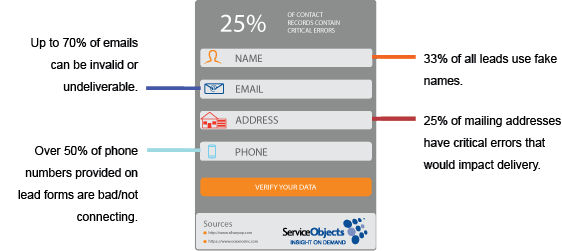Savvy marketers know just how important it is to capitalize on every customer lead. And as technology advances and our customer lists expand, so does the need to streamline our marketing campaigns and processes. But so many businesses are missing the boat when it comes to keeping their contact records accurate, genuine, and up to date. The reason? Poor contact record data quality.
Let’s face it, marketing platforms can only take your campaigns so far. The reality is—they are only as good as the contact records within them, leaving a lot of room for error. Yes, it is humans entering their data and we know that humans make mistakes. From something as simple as duplicate records, falsifying info, simple data entry mistakes, to aging, out of date, or lost contact records, these components contribute to the erosion of your company’s contact records.
To give you some perspective, SeriusDecisions reports that 25% of customer data is inaccurate, containing critical errors. CRITICAL! That means that you’re missing out on converting 25% of your leads into customers. That works out to be 1 out of 4 of your contact records are corrupt. The sooner you can acknowledge that contact data quality issues exist in your company, the sooner you can move towards a solution.

Bad Data Equates to Negative Impacts
The first step in fixing the problems is to locate the areas being impacted by bad contact record data and then pinpoint those areas within your marketing platform that need correcting. Quite simply, there are some soft and hard costs associated with poor data quality. These are the areas where you will may see and feel the effects initially (soft costs):
- Decreased productivity from your sales teams
- Increased costs for Lead & Customer Acquisition, Marketing Automation,
and CRM fees. - Misspent marketing labor costs
- Increased risk of regulatory fines (e.g., Do Not Call compliance, SPAM traps).
- Increase in Customer Care efforts (resulting from unhappy customers)
Over time, these build up and begin to cause larger problems (hard costs). The major impacts being realized through increased costs and lost revenues. Perhaps you’re experiencing a high employee turnover rate or realizing that customers are walking? These consequences could be happening as a result of poor quality data.
The point is, you need to enact some cost effective measures that will identify where the bad data resides and then correct it. Once you’re back on track, you’ll want a maintenance and management system in place to keep your campaigns moving along smoothly and productively, i.e., via a data governance policy. Long story short, bad data is in your contact records and it is dragging down your marketing campaigns. But…it CAN be prevented!
Hungry for more? You can get the full picture about the impacts of poor data quality and how to prevent/improve it by downloading our white paper, “Marketing with Bad Contact Data: A Recipe for Disaster”













